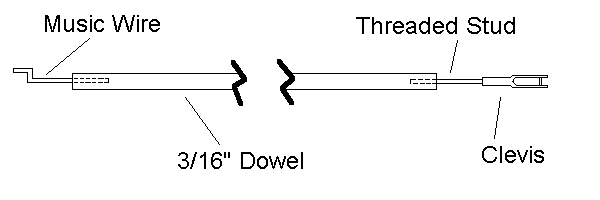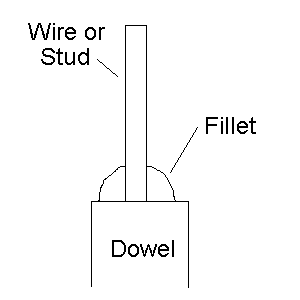

1. At one end of the dowel, drill a 3/32" hole right in the middle, to a depth of about 1/2". The easiest way I've found to do this (without a drill press) is to hold the dowel flat on a table with no overhang. Then carefully hold the drill with your other hand, position the bit in the middle of the dowel, and slowly drill. Don't apply too much pressure, you don't want it to slip! When done, tap the dowel on the table to let sawdust fall out.
2. Glue a threaded stud into the hole. I buy 1" long threaded studs in bulk from Hobby Lobby. What glue to use? I used to use epoxy, but have found that the hot glue I already have ready to go from building the rest of the plane works too (absolutely no failures have been experienced). Just apply some glue to the end of the stud and push into the hole in the dowel while turning. After that, apply a bead of glue like a fillet all around the end of the dowel to hold the stud even better.

3. Next thread the clevis (your choice of nylon or metal, again I buy them in bulk from Hobby Lobby. Thread enough of it onto the stud to allow a little adjustment in both directions.
4. Now fit the pushrod on the plane (which already has the control horns on and the servo in place). Line up the clevis with the horn (or actually attach if you wish) and determine the correct length to the servo. Remember to allow a space for the wire with the Z-bend, maybe about 2". Mark the dowel in the place to cut, then cut to length.
5. Now on the end of the dowel you just cut, drill a hole in the middle for the wire.
6. Cut the appropriate length of wire, make a Z-bend at one end, and glue the other end of the wire in the hole. Make sure that it reaches the servo arm with the arm in the center or neutral position. The wire doesn't have to hit the end of the hole, but if the hole isn't deep enough, either drill it deeper or shorten the wire a little.
7. When the glue has dried, hold the pushrod at the wire end and paint it to match the plane (if being used externally).
Notes:
Z-bend pliers are good to have to make very simple connections. They're available from many sources.
When drilling holes in the ends of the pushrods, if the dowel happens to split or if the hole is too close to the edge, just wrap the end in heavy thread with generous amounts of glue.